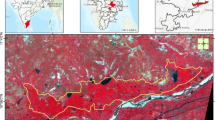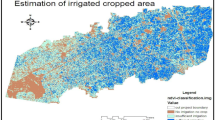Abstract
The paper focuses on analysing the irrigation water supply and demand of different crops under three main canals for kharif and rabi seasons in Dehradun region of Uttaranchal state. Crop acreage maps of rabi and kharif seasons have been prepared using LANDSAT TM 5 digital data by applying different image processing and classification techniques. Crop water and irrigation water requirements of different crops have been computed using CROPWAT computer program. Canal discharges have been compared with the irrigation water planning and management and found to be more than the irrigation water requirements in many months, that shows the need of revising the irrigation water management.
Similar content being viewed by others
References
Bastaanssen, W. G. M., Chemin, Y., Ahmad, M. D. and Asif, S. (1999). Patterns of crop evaporation in the indus basin recognised from the NOAA-AVHRR satellite. Proc. 2nd International Conference on Environment-Water, pp. 1–11.
FAO (1979). Soil survey investigations for irrigation. Soils Bulletin 42, Food and Agricultural Organisation of United Nations, Rome.
FAO (1992). Guide lines for predicting crop water requirements. Irrigation and Drainage paper 24, Food and Agricultural Organisation of United Nations, Rome.
FAO (1992). CROPWAT a Computer program for irrigation planning and management. Irrigation and Drainage Paper 46, Food and Agricultural Organisation of United Nations, Rome.
Hari Prasad, V., Chakraborti, A. K. and Nayak, T. R. (1996). Irrigation command area inventory and assessment of water requirement using IRS-1B satellite data. J. Indian Soc. Remote Sensing,24 (2): 85–96.
Lourens, U. (1990). Using Landsat TM to monitor irrigated land at the individual farm level. In Remote Sensing in Evaluation and Management of Irrigation, ed. M. Menenti, 231–235. Mendoza, Argentina: Instituto Nacional de Ciencia y Tecnica Hidricas.
Markham, B. L. and Barker, J. L. (1986). Landsat MSS and TM post-calibration dynamic ranges, exontmospheric reflectance and at satellite temperatures. EOSAT Landsat Technical Notes. No.1, 3–8.
Nageswara Rao, P. P. and Mohan, K. A. (1994). Cropland inventory in the command area of Krishnarajasagar project using satellite data. Int. J. Remote Sensing,15(6): 1295–1305.
Ray, S. S., Dadhwal, V. K., Chhabra, S. B. and Brahmabhatt, V. S. (September 2000). Application of remote sensing and geographic information systems in irrigation management of Mahi command area in Gujarat, India. National Natural Resources Management System (NNRMS) Bulletin, pp. 17–20
Thiruvengadachari, S. (1981). Satellite sensing of irrigation pattern in semiarid areas: An Indian study. Photogrammetric Engineering and Remote Sensing,46(5): 657–666.
Tiruvangadachari, S. and Sankthiradivel, R. (1997). Satellite remote sensing techniques to aid irrigation system performance assessment: A case study in India. Research Report 9, International Irrigation Management Institute, Colombo. 23 p.
UNESCO (2000). Water use in the world: present situation/future needs. http://www.unesco.org/science/waterday2000/water_use_in_the_world.htm.
Author information
Authors and Affiliations
About this article
Cite this article
Rao, K.H.V.D., Kumar, C.S.K. & Prasad, V.H. Irrigation Water Requirements and Supply Analysis in Dehradun Region—An Integrated Remote Sensing and GIS Approach. J Indian Soc Remote Sens 29, 59–67 (2001). https://doi.org/10.1007/BF02989915
Received:
Revised:
Issue Date:
DOI: https://doi.org/10.1007/BF02989915




